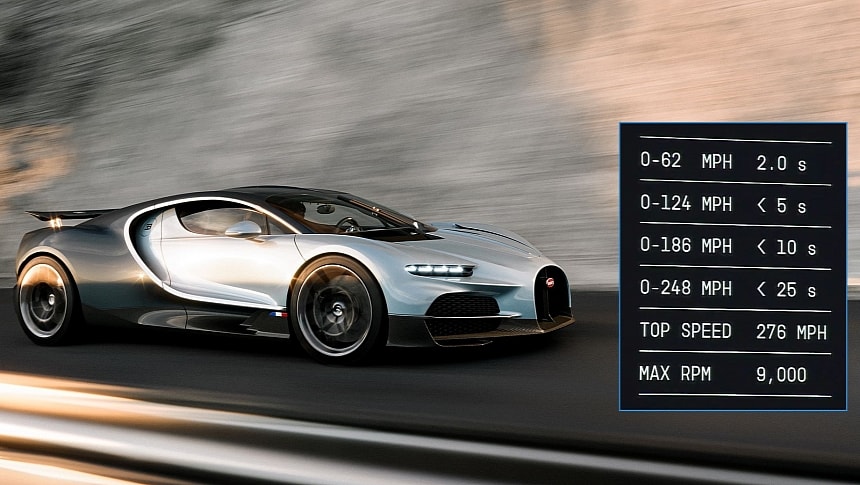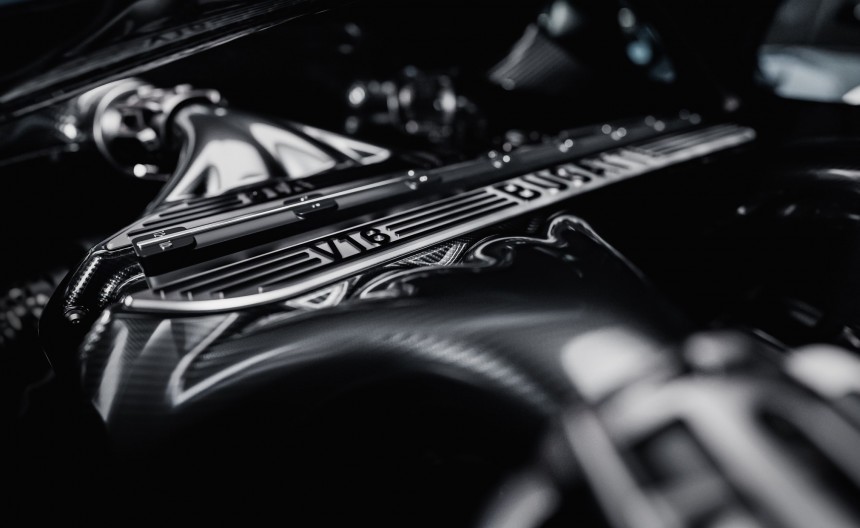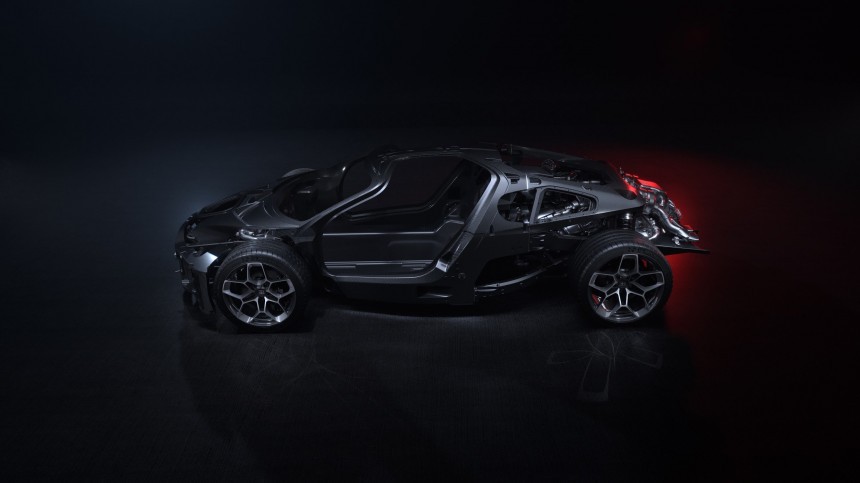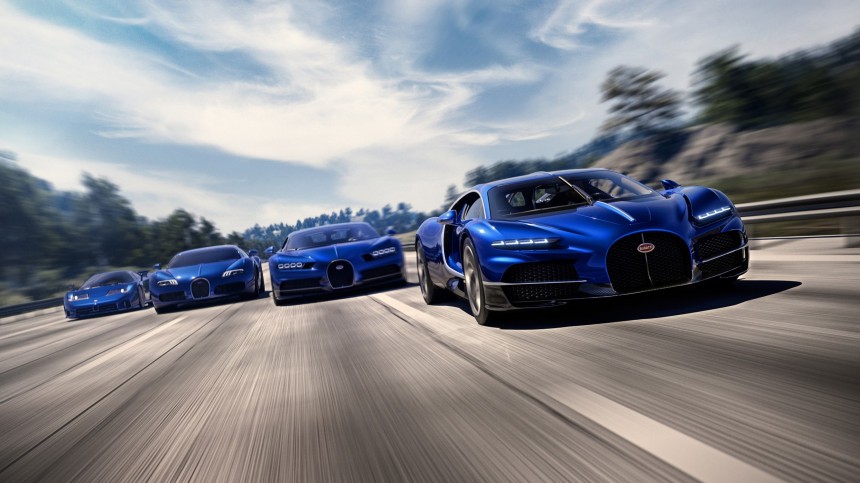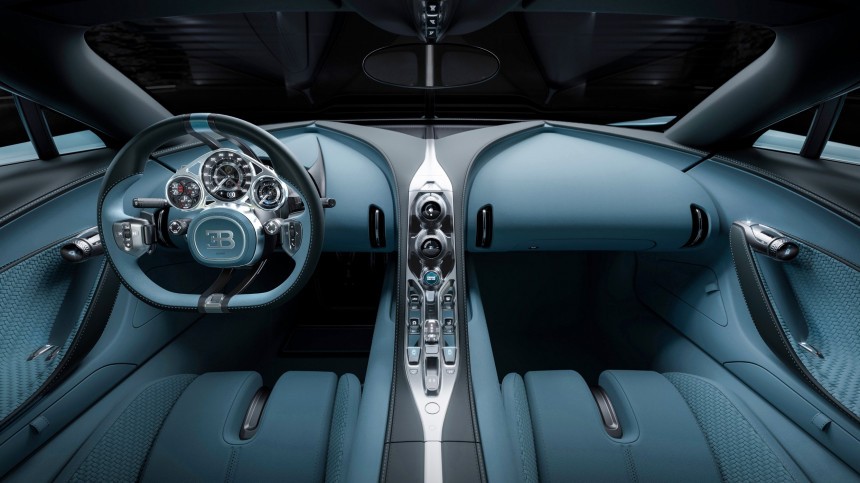Italian entrepreneur Romano Artioli reinvented the Bugatti marque at the beginning of the 1990s with the outstanding EB 110. Assembled in the Italian Republic, the brand's first modern production model set the course for the Ferdinand Piech-era Veyron, a full-on hypercar developed with the financial might of the Volkswagen Group. The Chiron followed suit a decade later, sporting a rather similar combination of style and quad-turbo W16 muscle. But for 2026, the French automaker has reinvented yet again with the help of the mad lads and lasses at Rimac.
Enter the all-new Tourbillon, which – according to big kahuna Mate Rimac – doesn't share a single component with its predecessor. First and foremost, let's talk pricing, exclusivity, and tentative start of deliveries. No more than 250 examples of the breed will be produced at 3.8 million euros net from the outset, which is more than 4 million dollars.
The hand-assembled masterpiece will enter production at some point during 2026, with production taking place at Bugatti Atelier in Molsheim. Named after the mechanical complication of high-end mechanical watch movements, Tourbillon will start deliveries after Bugatti puts an end to the W16 chapter with the final examples of the Bolide and W16 Mistral.
As you might have already heard, Bolide is a track-only special with the same maximum output as the road-going W16 Mistral. The latter, meanwhile, is best described as Chiron Roadster. As opposed to the Veyron, the Chiron was never offered in open-top guise. Nevertheless, the company will eventually make 99 units of the W16 Mistral.
From the standpoint of chassis and body design, Tourbillon uses T800 carbon composite to keep the weight as low as technically possible. How low? Think lower than Chiron low. The DIN figure is listed as under 1,995 kilograms or 4,398 pounds, whereas the Chiron was originally advertised with a DIN empty weight of 1,995 kilograms.
It's not exactly impressive at first glance, but you're well aware that we haven't seen the full picture yet. Instead of a combustion-only hypercar, Tourbillon is a plug-in hybrid with a 24.8-kWh battery, a front axle that integrates two electric motors, and one additional motor on the rear axle, right behind a bespoke V16 of the free-breathing variety.
Before going into the high-revving stuff, output numbers, and straight-line shenanigans, we should highlight its zero-emission driving range of more than 60 kilometers or 37 miles. In other words, Bugatti and Rimac shamed the F1-engined ONE from the folks at Mercedes-AMG. The downforce monster with a single-turbo V6 heart features an electric range of 18 kilometers or 11 miles.
The 90-degree V16 displaces 8.3 liters, meaning that it shares the V angle with the 4.0-liter V8 found in many performance vehicles produced by Volkswagen Group brands. Otherwise, it's a completely bespoke powerhouse, as one would expect from a Bugatti. The W16 engines of the Chiron and Veyron weren't shared with any other Volkswagen Group brands either. Contrary to popular belief, the 8.0-liter W16 isn't a couple of 4.0-liter W8s joined together. Just look at the cubic centimeters, bore, and stroke to understand.
Total output is 1,800 chevaux in French, a.k.a. pferdstarke in German or cavalli vapore in Italian. That’s 1,775 horsepower compared to the 1,578 horsepower of the Chiron's ultimate iteration, that being the record-breaking Chiron Super Sport 300+. An eight-speed longitudinal DCT channels those naturally aspirated ponies to the rear wheels.
The front-axle motors are good for 250 kW (340 ps or 335 hp) each, with full torque vectoring as the icing on the cake. As for the rear-mounted electric motor, that would be 250 kilowatts as well. Bugatti didn’t share maximum system torque, but we do know that 900 Nm (664 pound-feet) are produced by that 9,000-rpm leviathan of an engine.
France's most exclusive automaker did mention 240 Nm (177 pound-feet) for the rear motor. If the front motors also develop that kind of torque, it means that – in theory – Bugatti has unleashed a monster with 1,620 Nm (1,195 pound-feet) on tap. Absolutely mental, indeed! Because Rimac had a big say in the development of this fellow, it should come as no surprise that its near-25-kWh battery is an 800-volt unit with NCA 21700 cells that can be recharged from zero to 80 percent in 12 minutes.
The battery is a structural member of the car, located roughly in the same area where the Chiron's transmission tunnel goes. During the all-new model's presentation, Mate Rimac said the following: 200 kilograms (441 pounds) for the battery, 82 kilograms (181 pounds) for the electrified front axle, 23 kilograms (51 pounds) for the rear motor, and 11 kilograms (24 pounds) for the inverter. That's 316-odd kilograms or circa 697 pounds, which speaks volumes about Croatia-based Rimac's know-how for all things battery electric.
Attached below together with the debut release, the technical specifications sheet reveals 600-plus kilowatts from the electrical side of the powertrain. Together with the 1,000 pferdstarke of the naturally aspirated V16, that's more than the declared 1,800 ps (1,775 hp). Mate Rimac also said that Bugatti still has a bit more work to do until the Tourbillon is ready for production, meaning that weight and output might change a little by 2026.
Unmistakably Bugatti from every angle, Tourbillon is – like its forerunner – a fine combination of aerodynamics and elegance. Its aerodynamic diffuser starts from the passenger cabin area of the underbody and gently rises towards the rear, where it's topped by two exhaust finishers boasting a stretched pentagon motif. The diffuser integrates the crash structure, which is a very interesting crossover between two very different solutions.
Of course, an active rear wing is featured as well. It remains hidden at low and very high speeds, but raises automatically to improve stability under deceleration and while cornering. The iconic horseshoe front grille and overall front end may appear massive, but – amazingly – the frontal area is smaller than that of the Bugatti Chiron due to a number of tricks. For example, Tourbillon is 33 millimeters (1.3 inches) lower than the Chiron.
What Bugatti calls flying fenders is another trick worthy of your attention, for the incoming air is channeled underneath the headlights to the side intakes to feed that massive V16. The dihedral doors, meanwhile, are obviously inspired by those of the Rimac Nevera and quite a few other cars.
Zero to 100 kilometers per hour (62 miles per hour) takes a scarcely believable 2.0 seconds, which is better then the Tesla Model S Plaid's 1.99 seconds to 60 miles per hour (97 miles per hour). Normally limited to 380 kilometers per hour (236 miles per hour), Tourbillon clocks 445 kilometers (276 miles per hour) as long as the Speed Key is present. Chiron tops 420 kilometers per hour (261 miles per hour), whereas the Chiron Super Sport 300+ is electronically limited to 440 kilometers per hour (273 miles per hour). Without any electronic restrictions, the limited-run Chiron Super Sport 300+ reached a stupidly fast 490.484 kilometers per hour (304.773 miles per hour) at Ehra-Lessien.
A work of art inside, Tourbillon is equipped with a tourbillon-inspired analog instrument cluster that looks unbelievably cool. What's more, it's fixed in place as the rim of the steering wheel rotates around it, thus offering an unobstructed view of the instrumentation regardless of steering angle. It's even cooler to see the speedometer going up to 550 kilometers per hour (342 miles per hour), whereas the power gauge on the right side features two needles that indicate V16 and electrical power in real time. The left gauge's top area features the numbers 1/250 to remind you that you're a member of an exclusive club.
Oh, and one more – rather important – thing. Moving pedals and moving backrests are on the menu to the detriment of no forward or backward adjustments for the seats. Why is that? Because Bugatti Rimac's Tourbillon team didn't want to make the wheelbase any longer, with said wheelbase being 29 millimeters (1.14 inches) longer than the Chiron's 2,711 millimeters (106.7 inches).
The hand-assembled masterpiece will enter production at some point during 2026, with production taking place at Bugatti Atelier in Molsheim. Named after the mechanical complication of high-end mechanical watch movements, Tourbillon will start deliveries after Bugatti puts an end to the W16 chapter with the final examples of the Bolide and W16 Mistral.
As you might have already heard, Bolide is a track-only special with the same maximum output as the road-going W16 Mistral. The latter, meanwhile, is best described as Chiron Roadster. As opposed to the Veyron, the Chiron was never offered in open-top guise. Nevertheless, the company will eventually make 99 units of the W16 Mistral.
It's not exactly impressive at first glance, but you're well aware that we haven't seen the full picture yet. Instead of a combustion-only hypercar, Tourbillon is a plug-in hybrid with a 24.8-kWh battery, a front axle that integrates two electric motors, and one additional motor on the rear axle, right behind a bespoke V16 of the free-breathing variety.
Before going into the high-revving stuff, output numbers, and straight-line shenanigans, we should highlight its zero-emission driving range of more than 60 kilometers or 37 miles. In other words, Bugatti and Rimac shamed the F1-engined ONE from the folks at Mercedes-AMG. The downforce monster with a single-turbo V6 heart features an electric range of 18 kilometers or 11 miles.
Total output is 1,800 chevaux in French, a.k.a. pferdstarke in German or cavalli vapore in Italian. That’s 1,775 horsepower compared to the 1,578 horsepower of the Chiron's ultimate iteration, that being the record-breaking Chiron Super Sport 300+. An eight-speed longitudinal DCT channels those naturally aspirated ponies to the rear wheels.
The front-axle motors are good for 250 kW (340 ps or 335 hp) each, with full torque vectoring as the icing on the cake. As for the rear-mounted electric motor, that would be 250 kilowatts as well. Bugatti didn’t share maximum system torque, but we do know that 900 Nm (664 pound-feet) are produced by that 9,000-rpm leviathan of an engine.
The battery is a structural member of the car, located roughly in the same area where the Chiron's transmission tunnel goes. During the all-new model's presentation, Mate Rimac said the following: 200 kilograms (441 pounds) for the battery, 82 kilograms (181 pounds) for the electrified front axle, 23 kilograms (51 pounds) for the rear motor, and 11 kilograms (24 pounds) for the inverter. That's 316-odd kilograms or circa 697 pounds, which speaks volumes about Croatia-based Rimac's know-how for all things battery electric.
Attached below together with the debut release, the technical specifications sheet reveals 600-plus kilowatts from the electrical side of the powertrain. Together with the 1,000 pferdstarke of the naturally aspirated V16, that's more than the declared 1,800 ps (1,775 hp). Mate Rimac also said that Bugatti still has a bit more work to do until the Tourbillon is ready for production, meaning that weight and output might change a little by 2026.
Of course, an active rear wing is featured as well. It remains hidden at low and very high speeds, but raises automatically to improve stability under deceleration and while cornering. The iconic horseshoe front grille and overall front end may appear massive, but – amazingly – the frontal area is smaller than that of the Bugatti Chiron due to a number of tricks. For example, Tourbillon is 33 millimeters (1.3 inches) lower than the Chiron.
What Bugatti calls flying fenders is another trick worthy of your attention, for the incoming air is channeled underneath the headlights to the side intakes to feed that massive V16. The dihedral doors, meanwhile, are obviously inspired by those of the Rimac Nevera and quite a few other cars.
A work of art inside, Tourbillon is equipped with a tourbillon-inspired analog instrument cluster that looks unbelievably cool. What's more, it's fixed in place as the rim of the steering wheel rotates around it, thus offering an unobstructed view of the instrumentation regardless of steering angle. It's even cooler to see the speedometer going up to 550 kilometers per hour (342 miles per hour), whereas the power gauge on the right side features two needles that indicate V16 and electrical power in real time. The left gauge's top area features the numbers 1/250 to remind you that you're a member of an exclusive club.
Oh, and one more – rather important – thing. Moving pedals and moving backrests are on the menu to the detriment of no forward or backward adjustments for the seats. Why is that? Because Bugatti Rimac's Tourbillon team didn't want to make the wheelbase any longer, with said wheelbase being 29 millimeters (1.14 inches) longer than the Chiron's 2,711 millimeters (106.7 inches).
